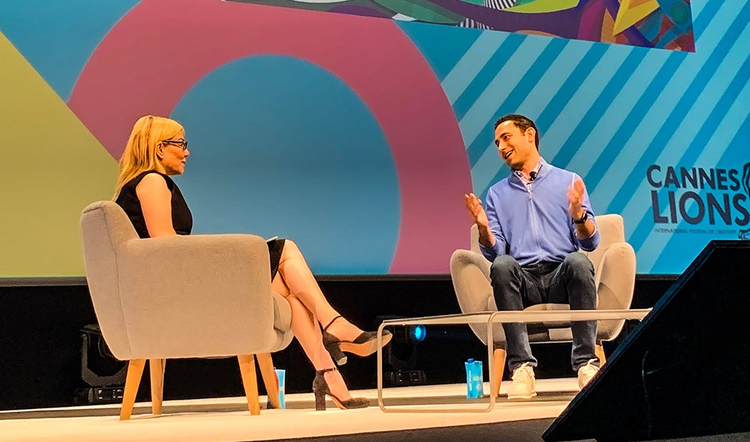3 Trends That Are Changing Creativity As We Know It
A trio of trends about creativity emerged during a packed session at the opening day of the Cannes Lions International Festival of Creativity in France.

This article is part of our Cannes 2019 collection. Click here for more.
Creativity is becoming more collaborative, the nature of brands is morphing, and artificial intelligence is becoming an important member of every design team. Those were the three main trends identified by Debbie Millman, host and founder of the “Design Matters” podcast, and Scott Belsky, Adobe’s chief product officer, during a packed session at the opening day of the Cannes Lions International Festival of Creativity in France.
Collaborative Creativity
Millman and Belsky discussed the notion of collaborative creativity as younger generations enter the workforce. This cohort brings with them their expectations for hyperconnectivity and working alongside colleagues, peers, and friends.
“Branding is really a team sport,” Millman said. “There are so many hands that go into the game of branding.”
However, the generations don’t quite see eye to eye in terms of how much collaboration they prefer, Belsky said.
“When we go to our customers and say, ‘Would you ever want Photoshop to be a collaborative tool? Would you ever want someone else to be in the same document as you, working alongside you?’ it’s fascinating to see the split of responses,” he told the audience. “Some people say that would be an absolute nightmare. Then you go to a new generation of people who grew up with Google Docs and chat and Slack and Facebook and everything else, and they just assume that a creative tool should be collaborative.”
Both Belsky and Millman agreed that shared creativity is the way forward for businesses. “If we’re willing to share our homes and our cars and our lives online, then why wouldn’t we be sharing our creativity?” Millman told the audience. “The more we can give up ownership in terms of the solo practitioner working alone, the more likely we are to be able to create something bigger than ourselves.”
Artificial Intelligence
AI and machine learning play an important role in enhancing the creative process, from start to finish. AI can help with ideating, creating, and informing the most effective assets.
According to Belsky, AI should be a welcome addition to the design/creative team. Just think about how much of a typical creative professional’s work is mundane, repetitive labor vs. being curious, learning, absorbing, taking risks, and trying new things.
“We’re realizing that maybe more than half of everyday work is repetitive, mindless stuff,” Belsky said. “If you can think about machine learning and artificial intelligence as tools for some of those things, you can make a big difference in the lives of creatives.”
And rest assured, Millman said, AI will not take away creative jobs.
“The one thing that I feel pretty confident [about is] that AI won’t be able to take over is the notion of curiosity and imagination—imagining something that isn’t there,” she said. “We as a species on this planet are the only ones that have this imagination to think about and imagine and plan scenarios for the future.”
Changing Nature Of Branding
Creativity is a critical component of building and managing a brand. Imaginative campaigns, experimenting with new strategies, and taking a stand enable brands to be credible and personal.
Millman’s advice: “If a brand is looking to create what they stand for through their audience, they’re doomed. A brand has to have a point of view that then captures the imagination of an audience.”
It’s no surprise, Belsky said, that modern enterprises are trying to act more human in order to resonate with their audiences. But in order to achieve that human touch, companies need to empower employees and give them freedom to create.
“You want to build the capacity of people, give them some building blocks, give them some wiggle room; you have to take some risks,” he said. “ … This is where you start to see the benefit of allowing people to play. You have to outfit your people to be stakeholders of creativity by giving them access to the style sheet. Then you have a learning cycle, where you celebrate the things that worked so people do more of it, and you discuss the things that didn’t work so people can self-correct and take it from there.”
The Life Of A Creative Professional
In this digital world that we live in, creatives constantly need to be agile, adaptive, and capture that perfect balance of advertising that doesn’t feel like advertising. According to Millman, “the biggest change over the past 10 to 15 years has been the need for every creative to be a polymath,” she said. “Everybody’s sort of expected to do everything.”
Her advice to the creatives in the audience is to have the confidence to do something creative in the future.
**“**If you’re waiting for that [confidence], it’s never going to come because confidence only comes from the successful repetition of any endeavor. Why do we think we need to be good at something before we’ve even started it?”
To help chart the future of creativity, Adobe is hosting a series of roundtable sessions at CLX, a new immersive and interactive program at Cannes Lions. Our roundtables explore what the next generation of creativity looks like and how brands can leverage key components of the digital world, including data insights, voice, AI, augmented reality, and 3D content creation, and incorporate them into their storytelling.